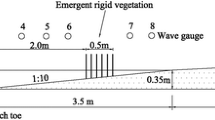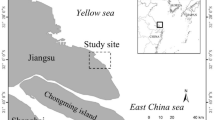Abstract
The primary objective of this study was to delineate the impact of vegetation on dune erosion under the influence of storm waves. This was achieved through laboratory flume experiments. Specifically, physical model experiments were used to identify the features responsible for coastal dune erosion generated by storm waves under the protection and non-protection of vegetation cover. Observations were then formulated based on the effective variables such as wave height and period, vegetation and sediment characteristics through Buckingham pi theorem to obtain dimensionless parameters like fall speed, vegetation length, depth and wave steepness parameters. Among the dimensionless parameters, the vegetated length parameter was effective in defining, measuring and comparing the coastal dune erosion. Based on vegetated length parameter, the change in erosion volume per unit width was calculated as 9.7–74% for regular wave conditions and 2.9–70.1% for irregular wave conditions. Furthermore, as the vegetated length parameter reduced wave damping ratio was not significantly affected, whereas the increase in the vegetated length parameter increases the wave damping ratio up to 0.5. As a result, the wave attenuation was recorded between 45 and 50%. An approach to correlate the wave energy coming out of the vegetation field with the energy necessary to erode the coastal dune profile depicted a linear correlation. As a result, empirically based equations have been developed to be used in soft coastal defense approaches which predict the volume of dune erosion and the wave attenuation under the protection of emergent vegetation. In addition, the energy required for the evolution of dune erosion is formulated in terms of attenuated wave energy.










Similar content being viewed by others
References
Akgul MA, Yilmazer D, Oguz E, Kabdasli MS, Yagci O (2013) The effect of an emergent vegetation (i.e. Phragmistes australis) on wave attenuation and wave kinematics. J Coast Res 65:147–152
Augustin LN, Irish JL, Lynett PL (2009) Laboratory and numerical studies of wave damping by emergent and near-emergent wetland vegetation. Coast Eng 56(3):332–340
Ayat B, Kobayashi N (2015) Vertical cylinder density and toppling effects on dune erosion and overwash. J Waterw Port Coast Ocean Eng 141(1):04014026
Bouhmadouche M, Hemdane Y (2016) Erosion of a sandy coast: continuous follow-up of the coastal groynes of protection in Boumerdes (Algeria). Environ Earth Sci 75(10):866–874
Danielsen F, Sørensen MK, Olwig MF, Selvam V, Parish F, Burgess ND, Hiraishi T, Karunagaran VM, Rasmussen MS, Hansen LB, Quarto A (2005) The Asian tsunami: a protective role for coastal vegetation. Science 310(5748):643
Donnelly C, Kraus N, Larson M (2006) State of knowledge on measurement and modeling of coastal overwash. J Coast Res 22(4):965–991
Flor-Blanco G, Pando L, Morales JA, Flor G (2015) Evolution of beach–dune fields systems following the construction of jetties in estuarine mouths (Cantabrian coast, NW Spain). Environ Earth Sci 73(3):1317–1330
Gravesen H (2003) The importance of experiments for marine engineering design practice. Hydrolab II: towards a balanced methodology in European hydraulic research, Budapest, May 22–23
Gutierrez BT, Williams SJ, Thieler ER (2007) Potential for shoreline changes due to sea-level rise along the US mid-Atlantic region. US Geological Survey Open-file report 2007-1278, p 25
Han EJ, Park YS, Do KY, Park JH (2016) A study on soil loss rate assessment of vegetation mat measures. J Hydro Environ Res 10:21–31
Kaliraj S, Chandrasekar N, Magesh NS (2014) Impacts of wave energy and littoral currents on shoreline erosion/accretion along the south-west coast of Kanyakumari, Tamil Nadu using DSAS and geospatial technology. Environ Earth Sci 71(10):4523–4542
Kobayashi N, Raichle AW, Asano T (1993) Wave attenuation by vegetation. J Waterw Port Coast Ocean Eng 119(1):30–48
Kobayashi N, Buck M, Payo A, Johnson BD (2009) Berm and dune erosion during a storm. J Waterw Port Coast Ocean Eng 135(1):1–10
Kobayashi N, Gralher C, Do KY (2013) Effects of woody plants on dune erosion and overwash. J Waterw Port Coast Ocean Eng 139(6):466–472
Kraus NC, Larson M, Kriebel DL (1991) Evaluation of beach erosion and accretion predictors. In: Coastal sediments 91, ASCE, Seattle, USA, pp 572–588
Larson M, Kraus NC (1989) SBEACH: Numerical model for simulating storm-induced beach change, empirical foundation and model development. Tech. Rep. CERC-89-9, Coastal Engineering Research Center, U.S. Army Corps of Engineers, Vicksburg, MS
Le Bouteiller C, Venditti JG (2014) Vegetation-driven morphodynamic adjustments of a sand bed. Geophys Res Lett 41(11):3876–3883
Li CW, Zeng C (2009) 3D numerical modeling of flow divisions at open channel junctions with or without vegetation. Adv Water Resour 32(1):49–60
Løvås SM, Tørum A (2001) Effect of the kelp Laminaria hyperborea upon sand dune erosion and water particle velocities. Coast Eng 44(1):37–63
Luhar M, Coutu S, Infantes E, Fox S, Nepf H (2010) Wave-induced velocities inside a model seagrass bed. J Geophys Res Oceans 115(C12):1–14. https://doi.org/10.1029/2010JC006345
Luhar M, Infantes E, Orfila A, Terrados J, Nepf HM (2013) Field observations of wave induced streaming through a submerged seagrass (Posidonia oceanica) meadow. J Geophys Res Oceans 118(4):1955–1968
Matsutomi H, Yamaguchi E, Naoe K, Harada K (2012) Damage to reinforced concrete buildings and coastal trees due to the 2011 off the Pacific coast of Tohoku earthquake tsunami. In: Lynett P, Smith JM (eds) 33rd conference on coastal engineering, vol 2, Hook, NY, pp 1848–1860
Möller I, Kudella M, Rupprecht F, Spencer T, Paul M, Van Wesenbeeck BK, Wolters G, Jensen K, Bouma TJ, Miranda-Lange M, Schimmels S (2014) Wave attenuation over coastal salt marshes under storm surge conditions. Nat Geosci 7(10):727–731
Mork M (1996) Wave attenuation due to bottom vegetation. Waves and nonlinear processes in hydrodynamics. Kluwer Academic Publishing, Oslo, pp 371–382
Nepf HM (1999) Drag, turbulence, and diffusion in flow through emergent vegetation. Water Resour Res 35(2):479–489
Nepf HM (2012) Hydrodynamics of vegetated channels. J Hydraul Res 50:262–279
Nepf HM, Vivoni E (2000) Flow structure in depth-limited, vegetated flow. J Geophys Res 105(C12):28547–28557
Perillo GM, Wolanski E, Cahoon DR, Brinson MM (2009) Coastal wetlands: an integrated ecosystem approach. Elsevier, Amsterdam
Riazi A, Türker U (2019) The drag coefficient and settling velocity of natural sediment particles. Comput Part Mech 6:427–437
Silva R, Martínez ML, Odériz I, Mendoza E, Feagin RA (2016) Response of vegetated dune–beach systems to storm conditions. Coast Eng 109:53–62
Stone GW, Finkl CW (1995) Impacts of Hurricane Andrew on the coastal zones of Florida and Louisiana: 22–26 August 1992. J Coast Res 21:1–364
Tanaka N, Sato H, Igarashi Y, Kimiwada Y, Torita H (2018) Effective tree distribution and stand structures in a forest for tsunami mitigation considering the different tree-breaking patterns of tree species. J Environ Manag 223:925–935
Tschirky P, Hall K, Turcke D (2001) Wave attenuation by emergent wetland vegetation. In: Edge BL (ed) Proceedings of the twenty-seventh coastal engineering conference. American Society of Civil Engineers, Virginia, pp 865–877
Türker U (2014) Excess energy approach for wave energy dissipation at submerged structures. Ocean Eng 88:194–203
Türker U, Kabdasli MS (2004) Average sediment dislocation analysis for barred profiles. Ocean Eng 31(14):1741–1756
Türker U, Yagci O, Kabdasli MS (2006) Analysis of coastal damage of a beach profile under the protection of emergent vegetation. Ocean Eng 33(5–6):810–828
Valyrakis M, Liu D, Mcgann N, Türker U, Yagci O (2015) Characterizing the effect of increasing river bank vegetation on the flow field across the channel. In: E-proceedings of the 36th IAHR world congress 28 June–3 July, The Hague, The Netherlands
Wang P, Kirby JH, Haber JD, Horwitz MH, Knorr PO, Krock JR (2006) Morphological and sedimentological impacts of Hurricane Ivan and immediate post storm beach recovery along the northwestern Florida barrier-island coasts. J Coastal Res 22:1382–1402
Yin J, Yin ZE, Hu XM, Xu SY, Wang J, Li ZH, Zhong HD, Gan FB (2011) Multiple scenario analyses forecasting the confounding impacts of sea level rise and tides from storm induced coastal flooding in the city of Shanghai, China. Environ Earth Sci 63(2):407–414
Acknowledgements
The authors would like to thank the associate editor and anonymous reviewers for their helpful and constructive comments that have contributed to improving the final version of this article. and are also grateful to Istanbul Technical University and Eastern Mediterranean University for making it possible for this study to be performed. The authors greatly appreciate their interest in coastal research and their support thereof and also appreciate Mr. Shawn Farrell for his efforts on final review of the manuscript as a linguistics specialist.
Author information
Authors and Affiliations
Corresponding author
Additional information
Publisher's Note
Springer Nature remains neutral with regard to jurisdictional claims in published maps and institutional affiliations.
Rights and permissions
About this article
Cite this article
Türker, U., Yagci, O. & Kabdasli, M.S. Impact of nearshore vegetation on coastal dune erosion: assessment through laboratory experiments. Environ Earth Sci 78, 584 (2019). https://doi.org/10.1007/s12665-019-8602-8
Received:
Accepted:
Published:
DOI: https://doi.org/10.1007/s12665-019-8602-8




